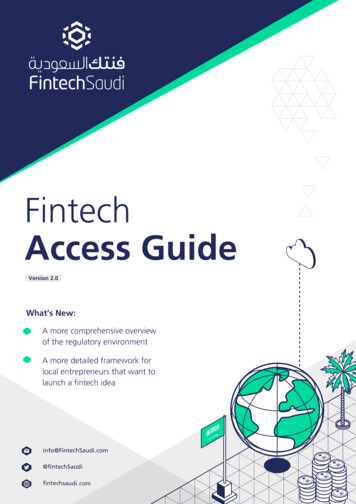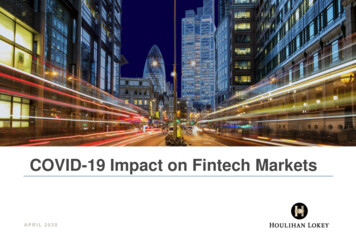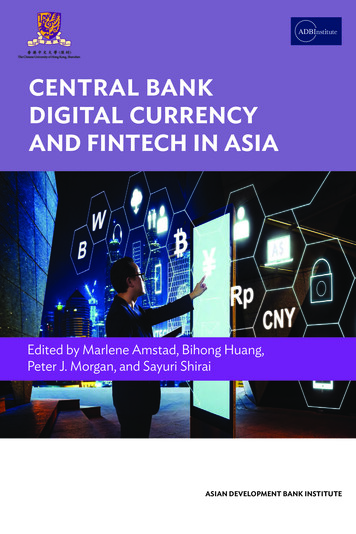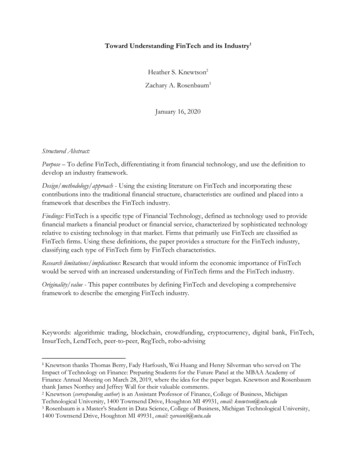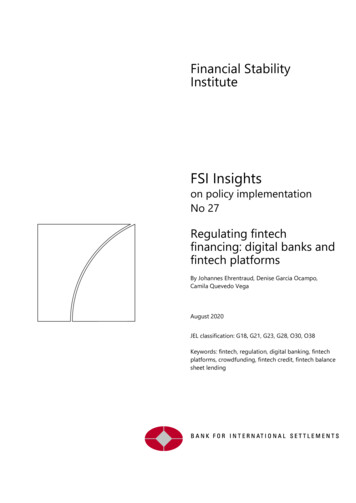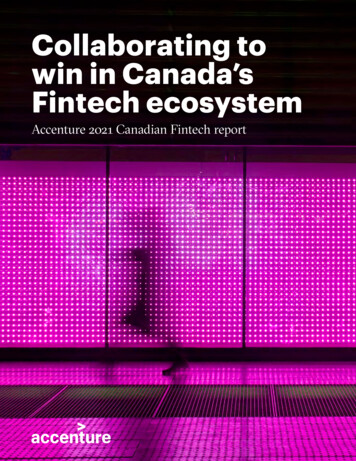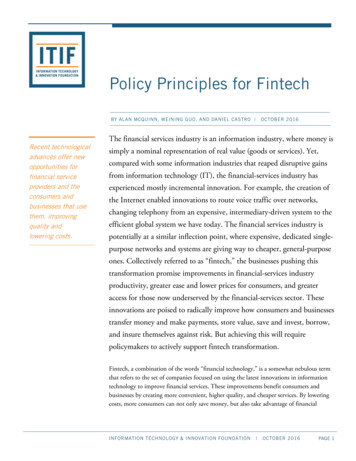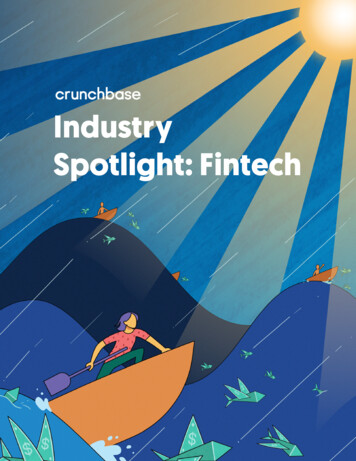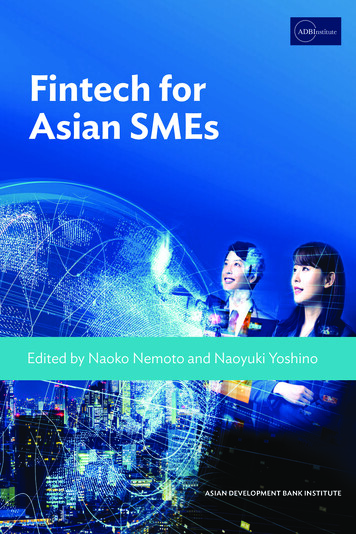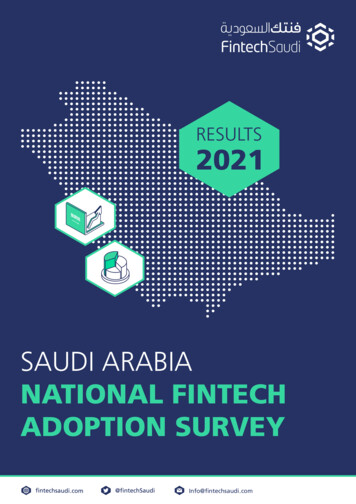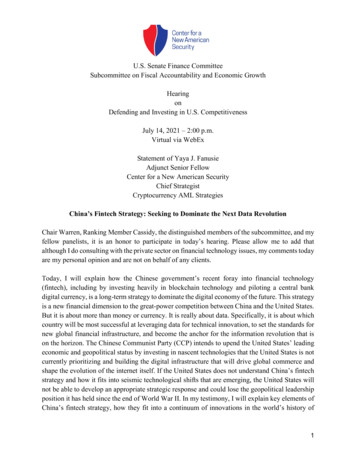
Transcription
U.S. Senate Finance CommitteeSubcommittee on Fiscal Accountability and Economic GrowthHearingonDefending and Investing in U.S. CompetitivenessJuly 14, 2021 – 2:00 p.m.Virtual via WebExStatement of Yaya J. FanusieAdjunct Senior FellowCenter for a New American SecurityChief StrategistCryptocurrency AML StrategiesChina’s Fintech Strategy: Seeking to Dominate the Next Data RevolutionChair Warren, Ranking Member Cassidy, the distinguished members of the subcommittee, and myfellow panelists, it is an honor to participate in today’s hearing. Please allow me to add thatalthough I do consulting with the private sector on financial technology issues, my comments todayare my personal opinion and are not on behalf of any clients.Today, I will explain how the Chinese government’s recent foray into financial technology(fintech), including by investing heavily in blockchain technology and piloting a central bankdigital currency, is a long-term strategy to dominate the digital economy of the future. This strategyis a new financial dimension to the great-power competition between China and the United States.But it is about more than money or currency. It is really about data. Specifically, it is about whichcountry will be most successful at leveraging data for technical innovation, to set the standards fornew global financial infrastructure, and become the anchor for the information revolution that ison the horizon. The Chinese Communist Party (CCP) intends to upend the United States’ leadingeconomic and geopolitical status by investing in nascent technologies that the United States is notcurrently prioritizing and building the digital infrastructure that will drive global commerce andshape the evolution of the internet itself. If the United States does not understand China’s fintechstrategy and how it fits into seismic technological shifts that are emerging, the United States willnot be able to develop an appropriate strategic response and could lose the geopolitical leadershipposition it has held since the end of World War II. In my testimony, I will explain key elements ofChina’s fintech strategy, how they fit into a continuum of innovations in the world’s history of1
data revolutions, and recommend ways that the United States must adapt and position itself tocompete with China in the 21st-century economy. But first, I’d like to start with some historicalcontext.From the late 1960s and into the early 1980s, a revolution in humankind’s transmission of dataoccurred, slowly. The internet was born. The infrastructure of the internet was constructed overdecades. It was a quiet data revolution. It happened largely outside the limelight because buildinga network for computers to talk to each other across great distances had little practical value forthe broader population, most of which had no direct access to computers at the time. So, creatingthe internet then was not a profit-seeking endeavour at first. Its impetus was military. At the heightof the Cold War, the U.S. Department of Defense funded computer science academics and gavethem a long innovation leash. 1 However, the DoD funders tethered the research to an ultimateobjective: to build computer infrastructure that would support the U.S. military’s information andcommunication needs around the world. 2 The internet protocol that we all engage in today, knownas TCP/IP, emerged in 1983. 3 But it was not until mostly American firms built civilian applicationson top of it, such as public websites and private email accounts, that the internet offeredmainstream value and revolutionized the world.No one entity or nation technically owns the underlying infrastructure of the internet. However, itcannot be denied that the United States’ decades-long investment in building it enabled U.S.companies to lead the technological and business growth that arose out of the internet’sinformation revolution. This position, however, is being challenged, slowly and steadily, by China.The clearest example of China working to upend America’s economic dominance on the internetis its Blockchain-based Service Network (BSN), a state-driven project that has partnered withChinese private tech firms to build what the Chinese Communist Party believes is the nextgeneration of internet infrastructure. The BSN, like the United States’ endeavour to build theoriginal internet, is a decades-long campaign. The BSN vision is an internet environment wheredata transmits through distributed broadcasting, in which separate applications and businesssystems can simultaneously access and operate on agreed-upon, authenticated data. 4 This contrastswith current internet processes, where data is siloed between different systems and moves throughthe internet in a linear fashion. In theory, this upgraded internet would enable an internet of thingswhere all digital things can communicate and transact with each other, enabling a new era of digitalBen Tarnoff, “How the Internet was Invented,” The Guardian, July 15, 2016, 2 Defense Advanced Research Projects Agency, ARPANET: Advancing National Security Through Fundamental Research,https://www.darpa.mil/attachments/ARPANET final.pdf.3 Justin Jaffe, “Happy Birthday, Dear Internet,” Wired, December 31, 2002, internet/.4 Yifan He, “Consensus 2021: Rebuilding the Internet with Blockchain Broadcasting,” Coindesk, May 6, lding-internet-blockchain-broadcasting.12
innovation and economic possibilities. But it would be an internet where China owns theunderlying infrastructure.Since blockchain technology emerged with the Bitcoin protocol in 2009, many technologists andentrepreneurs have argued that its distributed architecture model could eliminate long-lastinginefficiencies in data management and dissemination. In theory, this new way of recording andconveying data can revolutionize financial services, supply chain management, media, andgovernment recordkeeping. 5 In practice, these and other industries have yet to be disrupted by thenew technology. So blockchain, also known as distributed ledger technology (DLT), today remainsan experimental computer science niche with no single private or public sector entity dominatingits development. Yet, it is interesting that, instead of dismissing blockchain as over-hyped andunderperforming, China is doubling down on it. To understand why, let’s look at China’s overallapproach to new technologies and the state of global blockchain development over the past fewyears.Building Infrastructure Instead of ApplicationsChina’s research and development (R&D) strategy has two prongs, as described by Yifan He, theBSN’s executive director. 6 One approach is to invest in critical technologies that have evidentbenefits and established applications. 7 Some examples are robotics, semiconductors, and artificialintelligence. However, China faces stiff competition with the United States, which is alsoprioritizing R&D in these areas. The second approach is to pursue nascent technologies that nocountry has yet to dominate (and that perhaps most countries ignore). Such technologies may havefewer current applications, but would offer great potential first-mover advantage. Developingblockchain infrastructure is an example of this second approach. Executive Director He alsoexplained that China increasingly prefers to build new underlying technology, rather than developapplications on top of Western-dominated infrastructure. This approach seeks to capture marketshare at the outset of a relevant new technology. According to He, China’s approach is to look 50to 100 years ahead and then work toward the technological future. 8There are reasons why many outside China would ignore or dismiss the BSN. For example,although blockchain technology has received excessive media attention in the past few years, there5 Sam Wood, “Technology vs. Trust: Why this Wharton Professor Thinks Blockchain’s Time is Yet to Come,” The Philadelphia Inquirer, March 11,2019, ml.6 BSN, “Understand China’s Pursuit in Emerging Technologies,” Medium, June 10, 2021, t-in-emerging-technologies-af2104958a4a.7 Arjun Kharpal, “In Battle with U.S., China to Focus on 7 ‘Frontier’ Technologies from Chips to Brain-Computer Fusion,” CNBC, March 5, .html.8 BSN, Understand China’s Pursuit in Emerging Technologies.3
are no blockchain use-cases that have wide adoption except for cryptocurrency trading andspeculation. And the largest U.S. software companies that trumpeted the potential benefits ofdistributed ledger technology in early 2016 9 have mostly shuttered their blockchain serviceofferings by mid-2021. 10 Blockchain has not led to a massively popular software application thatis central to daily life and dominates a consumer market. There’s no blockchain killer app yet.However, this failure to achieve blockchain mass adoption and private sector profitability is similarto what would have happened if U.S. firms had launched internet service business divisions in the1970s. Computer networking was a niche technology space with infrastructure that was tooimmature to support any profitable business applications. IBM was producing computers at thattime, but the internet likely would not have arisen by IBM or any other private firm trying to buildglobal networking infrastructure single-handedly. The internet arose through computer scientistcollaboration where academic researchers iterated upon their protocols, seeking to build commoninfrastructure for all networked computers. In contrast, in the blockchain space, a wide variety ofstartups and developer groups around the world have been launching their own blockchainprotocols, each one competing with the others and touting its architecture as the best system toeventually deploy new, decentralized applications on the internet.The Chinese Communist Party views blockchain technology as strategically important, but itsassessment appears separate from the blockchain hype of five years ago. It was only in late 2019that China’s President Xi Jinping called on the country to excel in blockchain research anddevelopment. 11 In one interview, BSN Executive Director He said that he personally only startedlooking at DLT in 2018. 12 But much of the global hype around blockchain had already started tofade by this time. 13No blockchain killer app has emerged due to the regulatory uncertainty around the technology, thelack of interoperability between blockchain protocols, and the unsustainable costs for startupsunable to find product-market fit with unproven tech. However, a cursory study of how the UnitedStates developed the internet through government-funded R&D has likely given the Chinesegovernment a more promising blueprint for leveraging blockchain technology, which is to play theJamie Redman, “Microsoft & IBM Declare Blockchain Open for Business,” Bitcoin.com, February 17, 2016, kchain-open-business/.10 Ian Allison, “IBM Blockchain is a Shell of Its Former Self After Revenue Misses, Job Cuts: Sources,” Coindesk, February 1, ue-misses-job-cuts-sources; Joshua Mapperson, “Microsoft Quietly Closing Down AzureBlockchain in September,” Cointelegraph, May 14, 2021, losing-down-azure-blockchain-inseptember.11 “China’s Xi Urges Acceleration of Development of Blockchain Technology,” Reuters, October 25, 2019, ockchain-technology-idUSKBN1X419Y.12A. J. Cortese, “Red Date is Lowering the Entry Point to the Blockchain Network for SMEs,” KrASIA, April 24, 2021, inas-startups.13 Yaya Fanusie, “The Crypto Space is Void,” Forbes, December 18, 2018, 8/the-cryptospace-is-a-void/?sh 3cad8fad70ad.94
long game and pursue decades-long computer science experimentation and collaboration untiluniversal architecture emerges that can support practical applications. But instead of developinginternet plumbing that no one owns like the World Wide Web, 14 China’s vision of an upgradedinternet is more proprietary. The BSN secretary-general commented in late 2020 that the BSN isconstructing an online environment where China has “independent intellectual property rights andChina controls the rights to internet access.” 15Data is the New ElectricityThe BSN, as well as China’s central bank digital currency, must be understood as part of theChinese Communist Party’s broader fintech strategy. In late 2019, China unveiled a three-yearfintech development plan. 16 That strategy focuses more on data than money. The plan calls forChina’s financial system to get more nimble at acquiring and leveraging data, and to develop a“nationwide integrated big data center.” 17 The fintech plan is intertwined with similar CCPdirectives in recent years promoting the national development of big data analysis and artificialintelligence. 18 The Chinese government aims to collect and centralize as much data as possible forthe state’s monitoring and management, whether for economic aims or other party priorities.China’s aspirations to lead the internet’s evolution rely on data innovation. Digitization,intelligentization, and informatization are terms promoted in recent CCP national strategydocuments. 19 While these terms differ slightly in meaning, each is a political directive that involvesedifying state knowledge with internet-derived data. Although it is commonly said that “data isthe new oil,” it is more accurate to say that the Chinese government sees data as the new electricity.Like electricity, data in China is becoming a force to power all applications and economicprocesses in the country, with individual users (and their devices) connected to nationalinfrastructure.“History of the Web,” World Wide Web Foundation, the-web/.See 24-minute mark, “How Blockchain Technology and BSN Support Fintech Development,” Youtube, November 4, 2020,https://www.youtube.com/watch?v k9Gtq-j 3U.16“Chinese Central Bank Releases Fintech Development Plan for 2019-2021,” China Banking News, August 23, lan-for-2019-2021/.17 “The Central Bank Issued the ‘FinTech Development Plan’: Strengthening the Development and Application of Distributed Databases,”Blocking.net, .18Derek Grossman, Christian Curriden, Logan Ma, Lindsey Polley, J.D. Williams, and Cortez A. Cooper III, “Chinese Views of Big Data Analytics,”(RAND Corporation, 2020), h reports/RRA100/RRA176-1/RAND RRA176-1.pdf.19 Elsa B. Kania, Adjunct Senior Fellow in the Technology and National Security Program at the Center for a New American Security, “ChineseMilitary Innovation in Artificial Intelligence,” testimony to the U.S.-China Economic and Security Review Commission Hearing on Trade,Technology, and Military-Civil Fusion, June 7, %207%20Hearing Panel%201 Elsa%20Kania 20Intelligence 0.pdf; Katja Drinhausen and John Lee, “The CCP in 2021: Smart Governance, Cyber Sovereignty and Tech Supremacy,”(MERICS, June 15, 2021), ber-sovereignty-and-tech-supremacy.14155
Data also is the lens through which the United States must judge the geopolitical and economicimplications of China’s fintech advancement. The best way to do so is to consider what China’sfintech architects say about the data architecture they are building. Again, the planning aroundBSN exemplifies China’s wide-reaching data strategy.For example, throughout the world, most discussion on safety systems for self-driving carsproposes capabilities like simple vehicle-to-vehicle communication to allow cars to check nearbyvehicles’ current and anticipated movements. 20 Each vehicle would acquire and analyze dataemitted from other cars directly, but in piecemeal fashion, through linear transmissions. However,the BSN’s designers propose that blockchain-based broadcast transmission would allow all selfdriving cars within a set vicinity to exchange and synchronize data simultaneously, allowing formore efficient and comprehensive analysis of road activity. 21 Assuming transportation and safetyauthorities also access such broadcast data, these ongoing streams of information could feed hazardmonitoring, and help emergency response vehicles map quicker routes to crash sites and medicalfacilities. In China, such data would be distributed to approved parties, but would likely becentralized for government big data analysis. This constant feed of data would also inform machinelearning and lead to greater artificial intelligence capabilities for the government and possiblyprivate entities (like Chinese car manufacturers), if given permissions to the data.The implications for China’s transportation system and its automobile manufacturing sector wouldbe straightforward: potentially safer roads and more intelligent vehicles and infrastructure. Butthese enhancements would likely catalyze adjacent innovation in China’s food delivery sector, ridesharing, car insurance, mapping and geolocation software, and countless other areas.The international implications would arise from the response to one question: Will other nationschoose to implement this type of transportation intelligence system, run on capable and tested BSNinfrastructure? It should not be assumed that such a complex system could be built outside Chinawithout years of R&D. If many major cities around the world plug their transportation networksinto the BSN, car manufacturers would be incentivized to either make their vehicles compatiblewith BSN applications or to develop apps run on the BSN themselves. What would start as adomestic transportation sector innovation in China could transform into a significant hurdle forU.S. automobile industry competitiveness, especially if U.S. regulators prohibit U.S. firms frombuilding BSN compatibility due to national security concerns around data. And as other nationsseek the adjacent innovations for other industries operating on BSN’s transportation apps, U.S.firms in those industries could also find themselves at a competitive disadvantage. Even if the BSNis somehow constructed in a way where U.S. data is protected from Chinese governmentNational Highway Traffic Safety Administration, Vehicle-to-Vehicle Communication, evehicle-communication.21 He, “Consensus 2021: Rebuilding the Internet with Blockchain Broadcasting.”206
acquisition and regulators allow U.S. engagement, American firms would be forced to developimportant business applications on underlying infrastructure run by the Chinese tech sector. Thiswould be the inverse of the relationship between U.S. and Chinese technology firms today.The Digital Yuan is a Long-Term Concern for the United StatesThe disruptive potential of the BSN is similar to the risks to the United States around China’sDigital Currency/Electronic Payment, which is digitized central bank money known popularly asthe eCNY. This new project is better understood more as a new Chinese government-owned datanetwork rather than just as a currency. 22 Like the BSN, the eCNY’s implications for economic andgeopolitical competition are long term. This central bank digital currency (CBDC) also exemplifiesthe Chinese government’s pursuit of first-mover advantage in nascent technologies.The eCNY is unlikely to displace the U.S. dollar as the top international reserve currency in theshort term or to give China an immediate buffer against U.S. sanctions power. 23 The U.S. dollar istoo central to international trade and China’s restrictive monetary policies make the yuan, digitizedor not, less attractive for global users. 24The risk for U.S. displacement comes from the upper hand that China might gain in the long termby developing cross-border financial transaction infrastructure that a significant group of othercountries eventually adopt. The eCNY is only in a pilot stage and its monetary and economicbenefits for China are uncertain. What is clear is that China is seeking through the eCNY to builda more data-driven financial environment that would enable more technological innovation in itsfinancial sector. For example, in early 2021, the People’s Bank of China announced a domesticcall for academic research relating to the implementation of its digital currency. 25 In particular, thePBOC sought input on how smart contracts 26 could be integrated with the eCNY, including whatlegal frameworks would be needed. The central bank also requested research work on22Matthew D. Johnson, “China’s Digital Renminbi Initiative is a Network, Not a Currency,” The Strategist, Australian Strategic Policy Institute,June 16, 2021, enminbi-initiative-is-a-network-not-a-currency/.23 “Digital Yuan Gives China a New Tool to Strike Back at Critics,” Bloomberg, April 20, 2021, -at-critics.24 Yaya J. Fanusie and Emily Jin, “China’s Digital Currency: Adding Financial Data to Digital Authoritarianism,” (Center for a New AmericanSecurity,January 26, 2021), igital-currency.25 “Fading shuzi huobi chuangxin yanjiu kaifang keti shengqing zhinan (2021 niandu) [Application Guidelines for the Open Project of Legal DigitalCurrency Innovation Research (2021)],” The People’s Bank of China, March 26, 2021, http://archive.today/t84QT.26A smart contract is computer code that executes an agreement programmed within a blockchain platform. See: Stuart D. Levi and Alex B.Lipton, “An Introduction to Smart Contracts and Their Potential and Inherent Limitations,” Harvard Law School Forum on CorporateGovernance, May 26, 2018, dinherent-limitations/.7
incorporating the state’s digital currency with 5G and internet of things systems in order to spurmore innovative payment applications. 27Such research and experimentation is likely to give China leading expertise in the global pursuitof CBDCs. This knowledge advantage would put the Chinese government in position to drive theCBDC technical design and policy standards that other nations adopt. Signs of this are visible now.For instance, China is part of a Bank for International Settlements pilot project with the centralbanks of Hong Kong, Thailand, and the United Arab Emirates. 28 The project, known as theMultiple CBDC or mCBDC Bridge, is testing cross-border transactions between those centralbanks using a DLT platform. The United States does not appear to be closely involved with thepilot project.Because China is the largest economy with the most progress in CBDC development, it is likelyto have an outsized influence in the multilateral organizations that will recommend CBDCprototypes and standardization. This fits squarely with the CCP’s strategic approach: gain the firstfoothold in a nascent technology and dominate its proliferation as the rest of the world adopts it.The long-term risk for an alternative cross-border payment system to arise should not be dismissed.U.S. adversaries are not the only nation-states seeking to remove the centrality of the dollar to theglobal economy. Even central banks in U.S. ally countries are looking to lessen the world’sdependence on the dollar. In 2019, the governor of the Bank of England suggested that theinternational community should construct a new “synthetic hegemonic currency” through anetwork of CBDCs to facilitate international trade in the long run. 29 The mCBDC bridge seems tobe piloting that idea.If the future global financial system is built on the backbone of CBDC infrastructure, then thenation with the most CBDC expertise is likely to influence how the system is run. And althoughthe U.S. Federal Reserve is conducting some initial CBDC research and plans to release adiscussion paper on the topic soon, 30 China is clearly leading in this arena. The People’s Bank ofChina has been researching digital currency since 2014 31 and has released over 300 million worth“Application Guidelines for the Open Project of Legal Digital Currency Innovation Research (2021),” The People’s Bank of China.“Multiple CBDC (MCBDC) Bridge.” The Bank for International Settlements, 19 February 2021,www.bis.org/about/bisih/topics/cbdc/mcbdc bridge.htm.272829 Mary Carney, “The Growing Challenges of Monetary Policy in the Current International Monetary and Financial System” (Jackson HoleSymposium, Jackson Hole, Wyoming, August 23, 2019), icy-speech-by-mark-carney.pdf.30 Lael Brainard, “Private Money and Central Bank Money as PAyments Go Digital: an Update on CBDCs” (Consensus by CoinDesk 2021Conference, Washington, D.C., May 24, 2021), rainard20210524a.htm.31 Fanusie and Jin, “China’s Digital Currency: Adding Financial Data to Digital Authoritarianism.”8
of eCNY to the public in pilots around the country. 32 Those pilot transactions are likely generatingimmense data for the Chinese government to analyze and learn from.The Oneness of DataData certainly is becoming the new electricity, but not just in China. Big data, machine learning,artificial intelligence, and the internet of things are driving technological innovation in mostadvanced economies. The world is becoming more, not less, dependent on data moving throughthe internet. This trend is leading to a oneness of data that would appear to power almost everyaspect of our public and private lives.The prospect of living in a world plugged into ubiquitous and seemingly omniscient data can seemscary, and for good reason. The risks of undermining privacy, strengthening authoritarianism, andincreasing digital financial crime are great as more of our life activity operates online. There arealso various social spillover effects from our culture getting more fixated and dependent on ourdevices, screens, and data feeds.But at a time when advanced economies appear to be near the precipice of a fully digitizedexistence, now may be the best time for the United States to assert rules of the road for theincreasing role of data in our lives. The first step is to accept the inevitability of this technologicaladvancement in data transmission, while managing its societal shape. China’s preemptive strategyto gain prominence in blockchain-based broadcast transmission of data is a wake-up call for U.S.innovation. In order to chart a way forward that is consistent with American values, it is essentialto understand the long history of data revolutions.Data is simply information recorded and conveyed in written form. One of the world’s first datarevolutions occurred around 3000 BCE when the ancient Egyptians began writing on papyrus.That plant-based papyrus technology allowed for ink to be retained more easily on a portablewriting surface compared to writing on walls, stone, and clay. Later, the Egyptians began usingparchment made from animal skins as a writing tool. Parchment was more durable than papyrusand it became the medium that members of the early Jewish, Christian, and Islamic traditions usedto record and spread the Abrahamic message. 33 The Chinese are credited with inventing paperfrom plant fibers and cloth around the second century CE, but for hundreds of years, it was usedvery selectively and the art of papermaking was a closely-guarded skill. 34 It wasn’t until the rising“Spending with China’s Digital Yuan Around 300 Million, PBOC Says,” Reuters, November 2, 2020, illion-pboc-says-idUSL1N2HO0B1.33 Keith Houston, “Hidebound: The Grisly Invention of Parchment,” Longreads, December 1, e-grisly-invention-of-parchment/.34 Neathery Batsell Fuller, “A Brief History of Paper,” St. Louis Community College, July 2002, http://users.stlcc.edu/nfuller/paper/.329
Islamic civilization in the eighth century CE learned of paper from the Chinese that papermakingreceived assembly-line-like production. Thus, the scholars of the Golden Age of Islam wrote andreproduced hand-copied manuscripts on paper to transmit the leading scientific and literaryknowledge of their time. 35 However, interestingly, the Chinese were the first to invent papermoney during the Tang Dynasty between the 7th and 10th centuries CE.36 Papermaking spreadthroughout areas under Muslim control and to Europe by the 11th century through the Moorishinfluence in Spain. 37 Within a few hundred years, paper mills were common throughout Europe.It is important to note that initially, some European rulers resisted paper, seeing it as an unworthy,heathen-derived form of data transmission, especially unsuitable for Christian religious texts,which continued to use parchment. 38 The
are my personal opinion and are not on behalf of any clients. Today, I will explain how the Chinese government's recent foray into financial technology (fintech), including by investing heavily in blockchain technology and piloting a central bank digital currency, is a long -term strategy to dominate the digital economy of the futu re.
